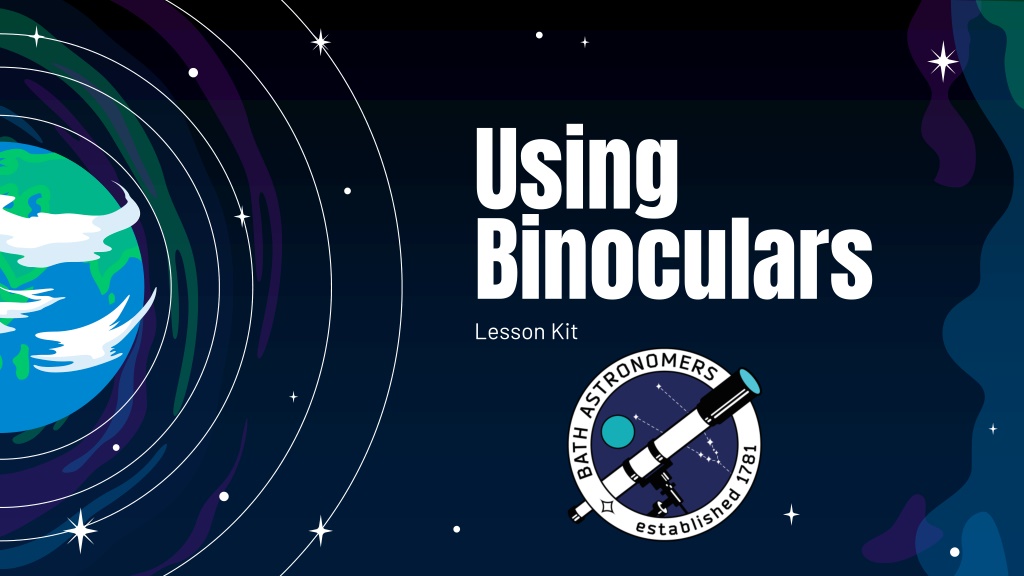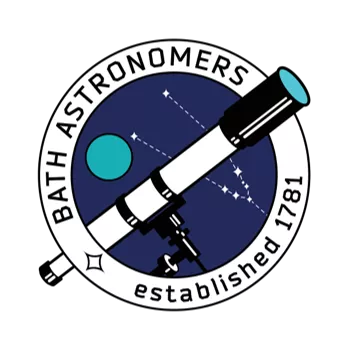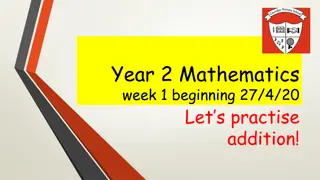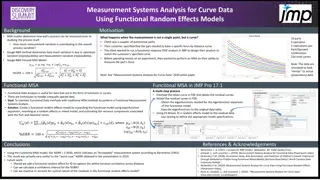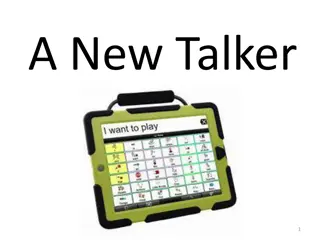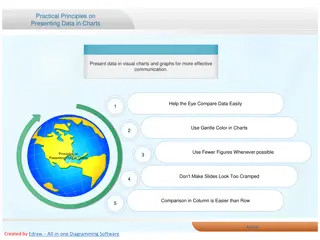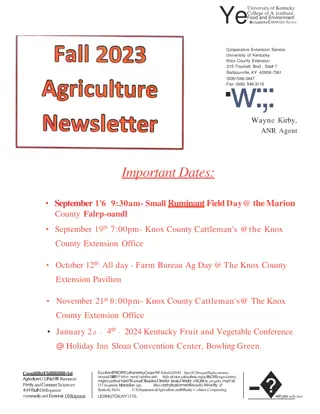Using Binoculars
Explore the world of binoculars with this informative lesson kit. Learn about different designs, understand what the numbers on binoculars mean, and get tips on using them effectively. Find out how to identify styles, follow safety guidelines, and practice using binoculars before stargazing. Engage in a quick quiz and discover top targets for observation. Educators can utilize the resource list to enhance learning experiences. Delve into the fascinating world of binoculars with engaging content and practical insights.
Download Presentation

Please find below an Image/Link to download the presentation.
The content on the website is provided AS IS for your information and personal use only. It may not be sold, licensed, or shared on other websites without obtaining consent from the author. Download presentation by click this link. If you encounter any issues during the download, it is possible that the publisher has removed the file from their server.
E N D
Presentation Transcript
Using Binoculars Lesson Kit
Contents Use these slides to introduce binoculars and plan observations. 3. 4. 5. 6. 7. 8. 9. 10. Review 11. Get in touch 12. Lesson plan 13. Credits Resource list Quick quiz Different designs What do the numbers mean? Try them out! Make a plan Top targets for binoculars
Resource List for Educators With our free loan box: Access for pupils to view the horizon and sky Knowledge of where North, South, East and West are in your location Without our free loan box: Access to binoculars (try donations, pupils own, or consider applying for a loan through your local stargazing society) Access for pupils to view the horizon and sky Knowledge of where North, South, East and West are in your location Never look at the sun through binoculars or other lenses.
Quick quiz! What other stargazing kit are binoculars quite like? Two Prisms and lenses They are like two telescopes
Different designs Can you recognise which style of binoculars you have used or seen? Get out a pair of binoculars and take a look! You ll need to have a pair to look at for the next few slides. Discuss: How might light travel through the lenses and prisms? Good to know for later: The two tubes can be pushed closer together, or further apart, to fit your face. Good to know for later: The focusing ring will make images sharper or fuzzier. Image source: Britannica Kids
What do the numbers mean? You might notice a number on your binoculars -it looks like a multiplication from a maths lesson! The first number is the magnification, how much larger it makes the image you see. Bigger isn t always better. Wider lenses gather more light, which is great on dark nights for astronomy, and greater magnification helps with distant objects in space, but keeping heavier binoculars still in your hands is very tricky! The second number is how wide the eyepiece lenses are -measure them in millimeters and see for yourself! (Width of a circle is called diameter)
Try them out! Let's get comfortable using these before trying them on the night sky. Remember: NEVER look at the sun through lenses, including binocular lenses. 1. First, choose something far away as your target. It could be a church spire down the road, an interesting tree, or your friend at the end of the school field. 2. Put the binoculars to your eyes and if possible, use your hands to bring the eyepieces closer together or further apart. Everyone has a different distance between their eyes! 3. Next, turn the focusing ring with your index finger of the hand you write with. Moving it forward or backwards will help make your fuzzy looking target nice and sharp.
Make a plan! The key to spotting something great in the night sky is being prepared. Get ready for an astronomy observing event by trying the following. Don t miss our great suggestions for what you might see with binoculars on the next slide! 1. Time, date and place Check out our 2. Navigating the Night Sky lesson that can teach you about using a planisphere or skymap. Choose a date and time according to upcoming weather predictions, and choose a location with a good view of the horizons. Stay warm and safe 2. Think about the temperature and how long you plan to be out - wrap up warm! Keep lights low or use a red torch, and chose a location that is safe to be in at low-light levels. Check out the next slide for simple binocular friendly targets!
Top targets for Binoculars 1. 2. 3. 4. 5. Target Target Target Etc Maybe a checkbox tick list for kids to keep/stick into books as a pdf You can totally use the list of binocular targets found on the back of skymaps, include link and picture 6.
Review Can you summarise your experience with binoculars? What new knowledge or experience do you now have? What Binoculars Are You have learned what binoculars are, how they are like telescopes and different from telescopes, and how light travels through them through lenses and prisms. How to use You have adjusted binoculars for your face shape, and used the focus wheel to make the image sharper. You have practised spotting easy targets in the daytime. Applied learning You have made plans and efforts to observe something at night using binoculars, something you might not have noticed without these incredible lenses!
Get in touch! If you would like further information, activity ideas or just to ask questions, please feel free to get in touch! Bath Astronomers volunteers are all keen to support an engaging and enriching space science education. Simon Holbeche Chairperson Bath Astronomers Camilla Evans Lead STEM Educator Wishford Schools
Lesson plan - please copy and paste as required! LO: To try using binoculars to good affect, to observe something better by using binoculars This lesson s placement is recommended as lesson 2 of 5. View MTP. NC objectives Introduction Differentiation - support Main Activities Differentiation - extend Plenary EYFS - Understanding the world; Know some similarities and differences between the natural world around them and contrasting environments KS1 Year 2 Science Observe and describe weather associated with the seasons and how day length varies KS2 Year 5 Science, Earth and Space; describe the movement of the Earth and other planets relative to the sun in the solar system, describe the movement of the moon relative to the Earth KS3 Space physics; our Sun as a star, other stars in our galaxy, other galaxies Use the quick quiz to discuss what binoculars are, what they are similar to and how they are different to items such as telescopes or microscopes. Extend this by discussing binocular vision and depth perception with older pupils. Look at the binoculars available and approach viewing through them, adjusting to face and target by moving the binoculars and the focus wheel. Pupils may expect the circles in their view to perfectly overlap or remain separate - the image will almost seem like a venn diagram. Aim to focus for the centre of it. The moon is a great beginner s target for younger pupils. Observe it when it is waxing and waning to see the shadows cast by rugged mountains and craters, avoid observing it near the full moon as it is so bright as to appear quite plain . Make a plan Pupils should plan out an observation event, taking the date, time and weather into account. Use the previous lesson 2. Navigating the night sky to better plan observations in detail, as appropriate. Use the top targets list to make binocular specific observation plans. Extension: Use the binocular specific list of observations for the current month at skymaps.com (learn how to read skymaps in lesson 2, navigating the night sky) Review what pupils have learned or experience that is new. For further questions or support, do get in touch with Bath Astronomers. Older pupils could plan and organise a family friendly observation evening at their school. This lesson was created by Bath Astronomers, a group of amateur astronomers sharing a passion for observing the sky. Please continue to support our free space education efforts for all by giving credit where work is shared, visiting our social media sites or even becoming a member of our group.
CREDITS: This presentation template was created by Slidesgo Slidesgo, including icons by Flaticon, and infographics & images by Freepik Flaticon Freepik
